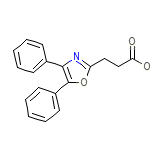Voir




Voir Brand names, Voir Analogs
Voir Brand Names Mixture
- No information avaliable
Voir Chemical_Formula
Voir RX_link
Voir fda sheet
Voir msds (material safety sheet)
Voir Synthesis Reference
Voir Molecular Weight
Voir Melting Point
Voir H2O Solubility
Voir State
Voir LogP
Voir Dosage Forms
Voir Indication
Voir Pharmacology
Voir Absorption
Voir side effects and Toxicity
Voir Patient Information
Daypro, like other drugs of its class, can cause discomfort and, rarely, more serious side effects, such as gastrointestinal bleeding, which may result in hospitalization and even fatal outcomes. Although serious gastrointestinal tract ulcerations and bleeding can occur without warning symptoms, patients should be alert for the signs and symptoms of ulcerations and bleeding, and should ask for medical advice when observing any indicative sign or symptoms. Patients should be apprised of the importance of this follow-up.
Patients should report to their physicians the signs or symptoms of gastrointestinal ulceration or bleeding, skin rash, weight gain, or edema.
Patients should be informed of the warning signs and symptoms of hepatotoxicity (e.g., nausea, fatigue, lethargy, pruritus, jaundice, right upper quadrant tenderness, and “flu-like” symptoms). If these occur, patients should be instructed to stop therapy and seek immediate medical therapy.
Patients should also be instructed to seek immediate emergency help in the case of an anaphylactoid reaction.
In late pregnancy, as with other NSAIDs, Daypro should be avoided because it will cause premature closure of the ductus arteriosus.














